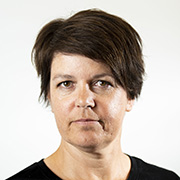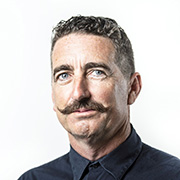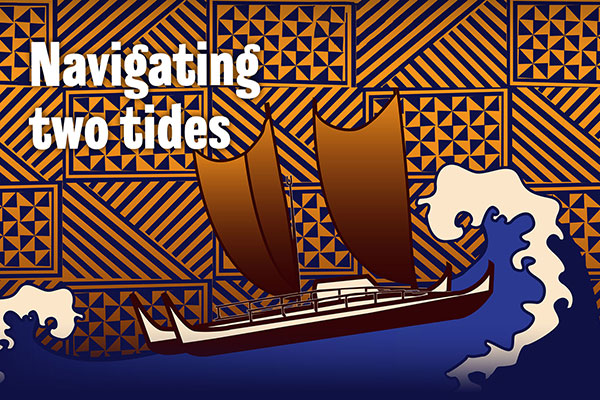
Being born in two cultures sometimes means you don’t know where you belong. Growing up NZ Chinese means being told you don’t look ‘Kiwi’ even if Aotearoa is the only home you’ve known.
Reporter Sally Kidson and visual journalists Virginia Woolf and Braden Fastier explore what it means to be New Zealand Chinese and the unique racism that attracts.
But WHERE are you FROM?
Made with support from


Artist Shane Hansen went through a major life crisis when his eldest son Nikau was born.
He suffered crippling depression and couldn't work for months.
Hansen is Chinese, Māori (Tainui, Ngāti Mahanga, Ngāti Hine), Scottish and Danish.
But being uncertain where he belonged in New Zealand was a major cause of his breakdown.
“I didn’t know who I was. I had this child and I didn’t know what to tell him,” Hansen says.
“And I was anxious about what he was going to have to deal with.”
Hansen’s whakapapa is rich and fascinating. But it is only as an adult he has come to see it as a gift.

Joe Kum Chee
Joe Kum Chee
His maternal grandfather Joe Kum Chee, was a Chinese market gardener who came from impoverished China in the 1920s.
He met Hansen’s Maōri grandmother Alice Chee (Williams) when she was about 14 and they had 11 children. Chee had a wife and daughter back in Guangdong which everyone knew about.
It’s an amazing story and one Hansen’s sister Mei-Lin Te Puea Hansen wrote the play The Mooncake and The Kumara about.
Hansen lives in a contemporary Northland home surrounded by his art works and lush native bush.
He is articulate, friendly and generous so it is hard to imagine he’s been uncomfortable in his own skin.
But for a long time he struggled to know where he belonged in Aotearoa.
He grew up more comfortable with his Chinese heritage as his grandfather “was very passionate about sharing his culture”.
Growing up - even in culturally diverse Manurewa - he wished he was white.
“That was my thing growing up. It would have been a lot easier as most of my friends were Pākehā …. I looked a certain way but I didn’t speak that way or didn’t have the culture so it just always felt like I didn’t fit.”

Virginia Woolf’s mother made her school lunch. The kind of lunch that makes your stomach growl just hearing about it.
But Woolf, a photographer, didn’t want to eat it in front of her peers.
Her midday meal, packed with delicious Chinese kai, was a reminder that she was different.
“All I wanted was to have peanut butter, marmite or jam sandwiches and iced animal biscuits that I could swap or trade. But no-one would trade with me.”
There were few Chinese children in her school and she stood out at a time when she badly wanted to be like her peers.
I always admired people with blonde hair and blue eyes, because they just blended in.
Woolf grew up in Gisborne.
Woolf’s dad Dick arrived in New Zealand aged 12 on documentation posing as his aunt's son.

Dick Ng
Dick Ng
He was sent to New Zealand alone to make a better life after the Communists came to power. His grandfather had owned a laundry in Wellington and retired to China, a relatively rich man.
Dick’s first six months in New Zealand were very hard. He lived with a relative who made him work in his market garden and didn’t give him enough food. He ate lemons from a tree for sustenance.
Woolf’s mother came to New Zealand as a young bride from Hong Kong.

Jamela Ng in the family’s fish and chip shop.
Jamela Ng in the family’s fish and chip shop.
Like many Chinese of the time, her parents were market gardeners and later ran a fish and chip shop.
They worked tirelessly to provide a better, easier life for their children.
Woolf’s homelife was very much Chinese. She grew up speaking Cantonese at home and English at school.
A memory that sticks is being in the sandpit at her primary school with two friends and they ran off. She thinks she spoke Cantonese and scared them.
At the time, I was thinking, what’s wrong with me?

Virginia Woolf with her mother Jamela Ng.
Virginia Woolf with her mother Jamela Ng.

Ask Robert King if he experienced racism growing up in the South Island and his demeanour changes. A darkness moves across his face.
“It hides in all sorts of places,” he says after a long pause. “It could be inclusion, it could be exclusion. But it is everywhere.
The racist person that is afraid to speak out or act out … They do it with their eyes. They do it with the way they look at you.
Like Woolf, King grew up in a traditional Chinese family.
He was also a takeaway kid helping out in his parents' Tinwald, Ashburton fish and chip shop, which his father purchased after market gardening.
King moved to New Zealand in 1962 aged seven months and has not been back to China. New Zealand is the only home he knows. It’s a home he loves.
This makes the racism he experiences in a country that prides itself on being egalitarian and kind so unfair.
“There are always people that remind you that you're not from around here,” he says. “I mean, it's quite noticeable that you don't look like everybody else.”

Emeritus professor Manying Ip says despite being a visible minority since the 1860s, Chinese are frequently regarded as “new immigrants''.
Ip has studied the “forever a foreigner” idea for decades - the view that Kiwis don’t see Chinese as belonging to New Zealand.
She’s interviewed a number of New Zealand born Chinese, including Chinese ANZACs and medical professionals who didn’t feel Kiwi despite New Zealand being their only home.
“Because they look Chinese, people still treated them like foreigners.”
Ip has lived in New Zealand since 1974 and published numerous books and articles in English. But even this year she was told she couldn’t join a small group of creative writers as she wasn’t a native English speaker.
“I got the shock of my life.”
Ip says stereotypes about Chinese remain strong. It’s a bitter joke among Chinese that they are responsible for all the country’s ills; from COVID, rising house prices, to taking jobs from “real New Zealanders'' and being a burden on the education and health system.
She’s noticed the racism hurled at Chinese in New Zealand is something not all Asian groups experience, and she’s curious why.
For example the growth in Indian and Filipino populations has not attracted the same vitriol.
“People still wouldn't look at a Chinese person and say;’ He or she is a New Zealander. But if they looked at a Filipino - they wouldn’t be sure.”

Virginia revisits Ormond School.
Virginia revisits Ormond School.
Type “Where are you from?” into an internet search engine and it turns up a number of articles, videos and discussion. Some posts are humorous, others more serious, but they all have the same message.
The four word question seems innocuous. But for the person being asked, it can be a dagger to the heart.
For Woolf - the question is a jarring reminder she looks different. Especially if she replies she is from Gisborne and they counter with; “No, Where are you REALLY from?”
What the person really is saying is you are not from New Zealand or around here.
“That’s when it makes me feel - oh, that’s right … I do look different. Even though I don’t feel different.”
When she first moved to Nelson 22 years ago a petrol station worker told her “gosh you speak good English”.
“I just stood there with my mouth open.”
It happened again recently and Woolf, while still gobsmacked, was ready.
“I said, well, so I should, I was born here and I’m a Kiwi.”

Shane has found art has been his therapy.
Shane has found art has been his therapy.
Hansen was shocked by the number of times he was asked where he was from by real estate agents while living in Christchurch.
He remembers thinking, “I’m from the North Island - are you for real?
It was hard for me to believe that they didn’t think I was from Aotearoa.

Distinguished professor Paul Spoonley says throughout New Zealand’s history the Chinese have been demonised “as though they were a threat or a problem in some way.”
He estimates 30 explicit pieces of legislation from the 1870s to 1950s were aimed at the Asians - but particularly the Chinese - making it difficult for them to enter or stay in Aotearoa.
The most well-known is the poll tax, an entry tax that singled out the Chinese. It started at 10 pounds and was raised to 100 pounds (today’s equivalent of about $18,000). It was abolished in 1944, but the Chinese couldn’t claim citizenship until 1951.

In 2002 Helen Clark’s government apologised for the poll tax and other discrimination aimed at the Chinese, but its effects are still raw.
To understand why the Chinese have been treated as outsiders for their time in NZ Spoonley says you need to look at New Zealand’s modern identity as a “Little Britain”.
For 98% of Aotearoa’s colonial history the majority of immigrants were from Britain and Ireland.
“Our society is very much defined by that British connection.”

Chinese gold miners with Reverend Alexander Don, outside a sod dwelling at Tuapeka, Otago. Credit: McNeur Collection Ref 1/2-019148-F
Chinese gold miners with Reverend Alexander Don, outside a sod dwelling at Tuapeka, Otago. Credit: McNeur Collection Ref 1/2-019148-F
The Chinese first arrived in New Zealand in the 1860s to seek a fortune on the Otago goldfields. As the gold ran out they spread out around New Zealand and moved into market gardens, fruit shops and laundries.
But despite their long history the “Chinese have been defined as the stranger. A person that does not fit,” Spoonley says.
This mindset still exists among older New Zealanders.
Spoonley says there was a resurgence of racism against Asians when immigration laws changed in 1986/87 and large numbers of Asians moved to New Zealand.
New Zealand First also got to power in 1996 on its “anti-immigration” platform which has been called a thinly veiled attack on Asians.
“I think that’s a period of very intense racism, which reflects a moral panic about Asian migrants.”

A Queen St, Auckland, crossing shows the diverse faces of a multicultural New Zealand.
A Queen St, Auckland, crossing shows the diverse faces of a multicultural New Zealand.
Ip and Spoonley say it is time to talk about New Zealand’s “multicultural reality”.
Because whether we are ready to embrace it or not. New Zealand is already multicultural.
The 2018 census showed that 41.6% of Auckland's 1.5 million residents were not born in New Zealand.
Asians at 15.1% of the population are the third biggest ethnic group. Māori at 16.5% is second.
Ip says as New Zealand is still working out its bicultural identity, talking about multiculturalism is a delicate subject for minorities and it is tricky to know when to make a stand.
However, increasingly she believes the issue should be debated.
She believes if Chinese genuinely felt they belonged as New Zealand citizens, the country would be able to show it genuinely does have an inclusive national identity.
Woolf is fiercely determined. She has made peace with being made to feel like an outsider as a child.
Coming to terms with her identity has also meant making peace with the cultural expectations of her parents who wanted her to study a safe profession and marry a Chinese man, she says.
She became a food technologist because that was what her parents expected. She had wanted a career in fashion.
Woolf has followed her passion and retrained as a photographer and is one of 15 Canon Masters in Australasia.
“I feel like I’ve achieved and made them happy for giving me a better life.”
She also married Dallen, a Canadian. This has helped her feel more accepted, she says.
Growing older has also seen her embrace her identity.
“What I love about it now is that I feel my heritage is important … I don’t want to hide it .. I feel more accepted now.”
One of her bugbears is that the census and other official forms don’t have a label that matches her ethnic background.
“I’m not a New Zealand European, I’m not Pākehā, I’m not Asian, and I’m not a Pacific Islander.
“If I get the option I will always tick ‘other’ and then I will write down that I’m a New Zealander of Chinese descent. Because that’s what I believe I am.”
Like Woolf, Hansen has visited China and been back to his ancestral village. Hansen says it felt familiar.
The house his grandfather helped build more than 100 years ago still exists - although it is now surrounded by factories, and high rises.
“It’s almost like his place is stuck in time. So you go inside there and there’s photos of all of us from Aotearoa on the wall. It’s very emotional.”
For Hansen art has been his therapy and a place where he is able to explore his Chinese and Māori identity and he loves that people see both those influences. Learning te reo has also been an important step in standing tall.
He now sees his breakdown as something he needed to go through.
He’s looking forward to the future and the one his boys - who also have South-African Indian heritage through their mother Kirsty - will experience.
“I’m pretty stoked that I’ve got these cultures ….
“I’ve really grown to appreciate that uniqueness. And I encourage my boys to be proud of their heritage and what they look like and who they are.”
Projects like this take time and resources. Please become a Stuff supporter and help enable this type of work.
Getting to the truth takes patience and perseverance. Our reporters will spend days combing through documents, weeks cultivating delicate sources, and months – if not years – fighting through the Official Information Act, courts and red tape to deliver their stories.
By supporting Stuff you'll help our journalists keep the pressure on. Make a contribution from as little as $1 today.










